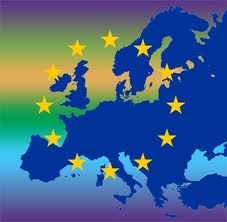
The unprecedented electoral success of Poland’s Law and Justice Party (Pis) has given the country its first majority government since 1989 and handed all positions of power to the ruling party.
The logical consequence of this is that it’s paved the way for “Gray Cardinal” Jaroslaw Kaczynski to streamline his vision for Poland, the de-facto reincarnation of Pilsudski’s Intermarium vision.
In the context of contemporary EU geopolitics, this has the potential to expand the American-controlled ‘bipolarity’ between Germany and France to include the more loyal and pro-American Poland, which would serve to divide Western Europe from Russia in the event of a détente between the two. European “tripolarity” is the perfect structural innovation in perpetuating the US’ control over the continent and catalyzing a ‘decentralizing’ chain reaction where other pro-American poles of power take on increased strategic significance, such as the Swedish-led Viking Bloc and the comparatively weaker albeit still existing Black Sea Bloc between Romania and Bulgaria.
The research starts off by describing the contemporary strategic context in the continental EU before seguing into an explanation of what exactly constitutes the Intermarum. Afterwards, the historical basis of this concept is touched upon before moving along to describing some of its finer details. The second part of the article talks about the resistant bloc that’s forming in the Central Balkans as a result, and concludes with a study of the three “squeaky hinges” that could slam the door shut on the Intermarum.
American-Supervised “Bipolarity” And The “Decentralization” Development
The present situation in Europe can be described as American-controlled bipolarity. In this structure, the US leverages its relations with Germany and France in order to disseminate its influence throughout the entire continent by proxy. It’s generally assumed that Berlin’s sway extends throughout Northern, Eastern, and Central Europe, whereas Paris’ is most prevalent in the Mediterranean areas of Southern Europe. This division can clearly be seen when it comes to each respective side’s respective disagreements over austerity, which has become an extraordinarily divisive point in the EU. With Germany leading one group of states and France the other, US influence over each of them amounts to continental rule by proxy, to say nothing of the direct control it exerts through NATO.
All Great Powers seem to understand this relationship, both between patron and proxy and in terms of each pole’s geographic sphere of influence in the EU, and they thus approach their diplomacy according to this two-track policy. When Germany and France are in agreement on a certain matter, then it’s all but assured that the rest of Europe will stand behind it, but when they differ on something, then the continental divide on the said issue widens and it’s difficult for progress to be made. When the US finds it ‘appropriate’, it interferes in the bilateral relations between these two poles in order to literally divide and rule, but sometimes things don’t work out quite like the US originally planned. The case in point that immediately comes to mind is the Minsk Agreement, where both Germany and France repelled American influence in sabotaging the initiative and instead threw their full diplomatic weight behind it.
This unprecedented insubordination to the US compelled Washington accelerate its preexisting plans for European “decentralization”, or in other words, militant NATO-led regionalism in order to shift the continental momentum east towards the US’ most loyal proxy states. The US fears that Germany, France, and the French satellite state of Italy, together the top three economies in continental Europe, could one day enter into a non-American-advised détente with Russia, thus slipping out of Washington’s control and endangering the US’ proxy rule over Europe. In response to the lingering unease that the US has over this scenario, it announced that its bloc of military subordinates would be setting up six regional command centers in the Baltics, Poland, Romania, and Bulgaria to emphasize Washington’s new focus on the so-called “frontline states”.
A New Constellation
It’s understood that this is happening at the expense of the US’ relations with its traditional European allies of Germany and France, but that’s the entire point – the US is demonstrating that although those states remain important in the overall sense of things via their American-managed “bipolarity” over the EU, “New Europe”, as Donald Rumsfeld so boorishly called it over a decade ago, is on the verge of replacing it in terms of American strategic priorities. The concept here is to embolden regional leaders in Northern and Eastern Europe, Sweden and Poland respectively, to take on increased responsibilities via the Lead From Behind strategy of “unipolar multipolarity”.
Sweden:
It doesn’t matter in this case that Sweden isn’t (yet) a NATO member because it already behaves as one of the bloc’s leading advocates, so it’s actually a moot point whether it even needs to de-jure join the organization. The same can be said for Finland, since it’s obviously abandoned the policy of “Finlandization” that was earlier named after it and is now an aspiring partner of the US. Swedish historical influence over Finland has plainly extended to the present political realm, since Stockholm has used its privileged ties with Helsinki to rapidly bring both of these non-NATO-member states solidly under the bloc’s wing. Including Norway, Iceland, and Denmark, “Greater Scandinavia” under Swedish leadership has become the US’ proxy fighting force in Northern Europe, the Viking Bloc.
Poland:
Directly south on the plains of Eastern Europe is Poland, which has exploited the New Cold War in order to arguably become the loudest proponent of NATO’s eastward surge. Warsaw is seeking to centralize as much NATO attention onto itself and its ambitions in order to achieve the multilateral ‘jump start’ that it needs in order to bring back the Polish-Lithuanian Commonwealth. This Neo-Commonwealth, as the author has previously called it, refers to the expansion of Polish kinetic and potential influence over the lands of its prior empire, especially over Belarus and Western Ukraine, which are the general targets here. Only Poland has the demographic and economic capability of pulling this off and achieving some sort of mild success, hence why the US encourages it to ‘call the shots’ in the region and become the ‘mascot’ of “New Europe”.
Romania/Bulgaria:
The third leg of this North-South ‘new’-NATO constellation is Romania and Bulgaria, two equally poor and weak states that nevertheless have been cultivated to become diehard NATO proponents. By themselves, these states can’t do anything of military worth, but in cooperation with and under the guidance of the US, they could become regional nuisances in the western Black Sea region. The US is attracted to Romania because of the potential that it has in triggering destabilization in Moldova on demand, as well as the possibility for its interference in Northern Bukovina amid any large-scale Ukrainian state breakdown. Although definitely in the long term, there’s also the possibility of Romania building (or buying) a modest navy with heavy American financial and technical support, which despite never being able to compete with its Russian counterparts, could at the very least prove to be a nuisance if outfitted with anti-missile technology.
Bulgaria appears to be a lot more useless than Romania on the surface of things, but in reality, it could play a crucial role in destabilizing Macedonia in the event that the Balkan Stream pipeline is completed. The Black Sea state has historically behaved in an imperial fashion towards its neighbor because it refuses to recognize that the country, ethnicity, and language even exist, believing them instead to be sub-sectors of Bulgaria and its identity. These ideas are no longer recognized on the official level, but they’re still wildly popular in society and among the country’s decision makers, which constantly try to position themselves as a “big brother” to Macedonia. This patronizing attitude is indicative of the ulterior motives that the Sofia elite harbor towards the people that they last occupied during World War II, and it’s an overlap of “natural” interest for the US to cooperate with Bulgaria in destabilizing Russia and China’s chokehold gateway into Europe.
Returning To The Historical Blueprint
Background:
What the US is pursuing in linking together Northern, Eastern, and Southeastern Europe into an anti-Russian alliance isn’t exactly a novel idea, since it was first attempted by interwar Polish leader Jozef Pilsudski through what he called the Intermarum, or “between seas”. This vision sought to integrate the countries straddling the Baltic and Black Seas into a unified strategic alliance under Polish leadership. It eventually fell apart owing to the divergent foreign policies of the prospective member states, as well as Poland’s geopolitical bullying of interwar Lithuania (occupying and annexing its historic capital, threatening war, etc.), which served to push its former ally as far away as possible from it and therefore isolate the rest of the Baltic States from Polish influence. While nothing more than an on-paper theoretical conception, the idea itself was attractive enough to future American and Polish strategists so as to warrant a second attempt when the opportunity sprung.
The Domino Effect Of Opportunism:
The post-Cold War environment proved extremely fertile for the US in expanding NATO and incorporating all of the projected Intermarum states besides Belarus and Ukraine. This advantageous state of affairs provided the US and its regional allies with the institutional capital to actualize Pilsudski’s dead dream, but all that was needed was the appropriate spark to set all the gears in motion. This was conveniently manufactured by the American-conceived EuroMaidan urban terrorist insurrection that resulted in the predictable New Cold War that was needed to ‘justify’ the Intermarum. Once the process was initiated, all of its members wanted in on it and in the most comprehensive manner possible. The domino effect of opportunism that began has created a frenzy among all of the participating states, as their governments (despite the indignation of certain segments of their populations) literally beg for as much of a NATO military presence as possible. The perceived benefit that they gain is strictly ideological and intangible, and in reality, it’s really an ironic welcoming of one military occupation in order to stave off a feared and extremely unlikely one from someone else.
Organizing The Intermarium
The below map is Europe’s forecasted military-political layout:
Key
* Black – Albania and the UK, the most direct instruments of the American military in Europe
* Pink – “Old NATO”, the member-states that will not partake in the Intermarum’s anti-Russian games
* Blue – The Viking Bloc
* Red – The Neo-Commonwealth
* Green – The Black Sea Bloc
* Brown – St. Stephen’s Space
* Yellow – The Central Balkans
* Gold – Russia, Belarus, and Donbass
What follows is an explanation of the key areas in the Intermarum:
The Baltics:
The international arena and global context have changed since the interwar years, and accordingly, the blueprint for the Intermarum has as well. As previously described, there are three central foci in this bloc, and they’re Sweden, Poland, and Romania, with Warsaw being the gravitational center holding it all together. The Baltic States are no longer seen as independent governments in their own right, but as nothing more than landlords with ‘legal’ right to ‘rent’ out their territory to any given military, most recently the US and UK. However, the current number of foreign military occupants isn’t sufficient to satisfy the paranoid fears of the host states, and it’s anticipated that there will eventually be an attempt made to draw them into the Viking Bloc and Neo-Commonwealth orbits. More than likely, Estonia and Latvia will sway towards Sweden, whereas Poland will try to lure Lithuania (but with uncertain success, as will be described later).
Ukraine:
It’s basically a fait accompli that Ukraine has become the military property of NATO, albeit minus the presence of formalized bases. The joint Polish-Lithuanian-Ukrainian brigade is a strong symbol of the Neo-Commonwealth’s stake over this territory, and given the historical connotations behind this move, it’s a given that Poland wants the country to become its premier stomping grounds in the future. Like with the Baltics, the only permanent NATO presence outside of the Neo-Commonwealth will probably remain the US and UK, even if they never make it official (due to the legal ‘loophole’ of rotating their forces for an unlimited number of times).
Moldova:
Similar to how Poland lays ‘stake’ to Ukraine via its historical legacy, Romania has done the same thing for Moldova, although the latter is arguably less closer to NATO than Ukraine is (although it’s still on a pretty cozy footing). Still, the potential for internal conflict is definitely there, be it through a Color Revolution, a Continuation War in Transnistria, or an outright annexation (be it through ballot or bullet) by Romania. For this reason, the geostrategic territory remains a flashpoint, but one which for the most part is under heavy influence from Bucharest (except, of course, for Transnistria).
St. Stephen’s Space:
This is the name of an emerging sub-bloc centered on Hungary, named for the famous King from that country. Right now it lays dormant, but there’s a strong possibility that it could be activated as the other Intermarum nodes rush to consolidate their spheres of influence. In that case, Budapest can be expected to extend is umbrella of historical influence over Croatia, which in turn will do the same to the Croat-Muslim portions of Bosnia. Much to the dismay of the locals and their government, Hungary may also try to exert itself over Slovakia, although it remains questionable whether or not it will succeed in this. Squeezed between Poland and Hungary, Slovakia might opt for the choice of the “devil it knows” and go with Hungary in some type of institutional cooperative framework (perhaps using the Visegrad Group as a forerunner for this). The overall scenario of St. Stephen’s Space becomes more probable if an even more right-wing government than Viktor Orban enters into power such as Gabor Vona’s Jobbik, which in that case might even try to leverage its influence over the Hungarian minority in Romania to blackmail Bucharest into submitting to its aspiring hegemony. It might also unintentionally provoke a crisis between the two states that could lead to unpredictable consequences, perhaps even including the strategic neutralization of both blocs following an Intermarum “civil war” between these two sides.
Andrew Korybko is the American political commentaror currently working for the Sputnik agency, exclusively for ORIENTAL REVIEW.
Source Article from http://www.globalresearch.ca/the-bipolarity-of-eu-geopolitics-and-the-us-sponsored-reincarnation-of-polands-intermarium-vision/5486276
Related posts:
Views: 0
 RSS Feed
RSS Feed

















 November 3rd, 2015
November 3rd, 2015  Awake Goy
Awake Goy 






 Posted in
Posted in  Tags:
Tags: 
















